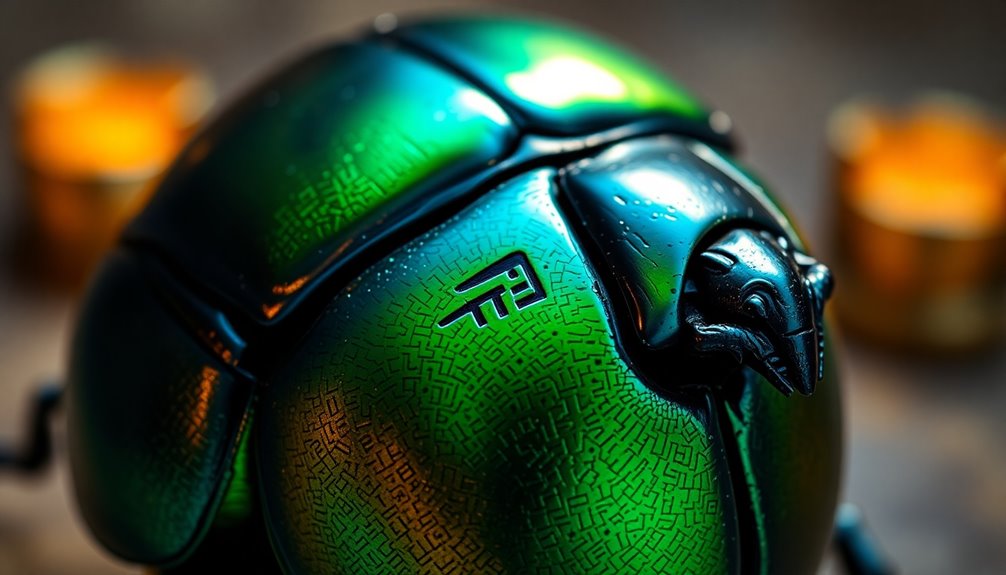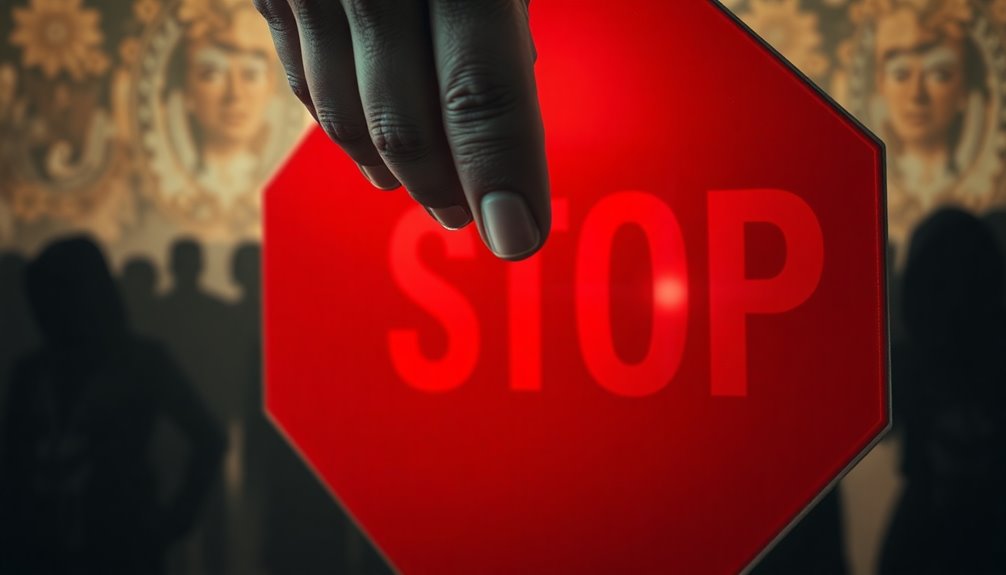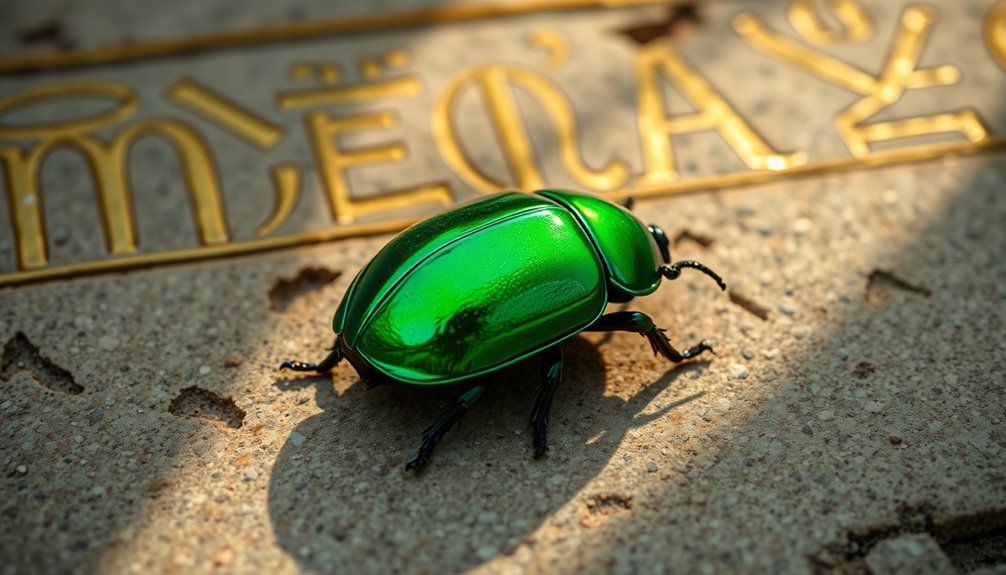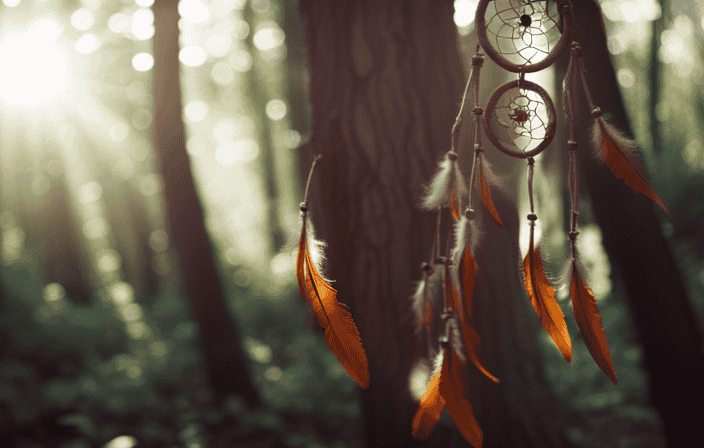The Egyptian beetle, known as the scarab, symbolizes life, rebirth, and protection. In ancient Egypt, these beetles were linked to the sun god Khepri, representing creation and the rising sun. You'd find scarabs in funerary practices, where they were placed on the deceased's chest for a safe journey into the afterlife. They also serve as powerful amulets, bringing good luck and protection. Today, scarab motifs inspire modern jewelry and art, reflecting their enduring significance. If you're intrigued by how these themes connect to today's culture, you'll discover even more fascinating insights.
Key Takeaways
- The scarab beetle symbolizes life, rebirth, and transformation, linked to the sun god Khepri in ancient Egyptian mythology.
- Heart scarabs were placed on the deceased during mummification to ensure safe passage and protection in the afterlife.
- Scarabs served as administrative seals, documenting important events in pharaohs' reigns and reflecting their significance in governance.
- The ecological role of scarabs includes dung decomposition, which promotes soil health and nutrient cycling, crucial for agriculture.
- Scarab motifs continue to inspire modern jewelry and art, representing themes of protection, good fortune, and renewal across cultures.
Ancient Symbolism of Scarabs
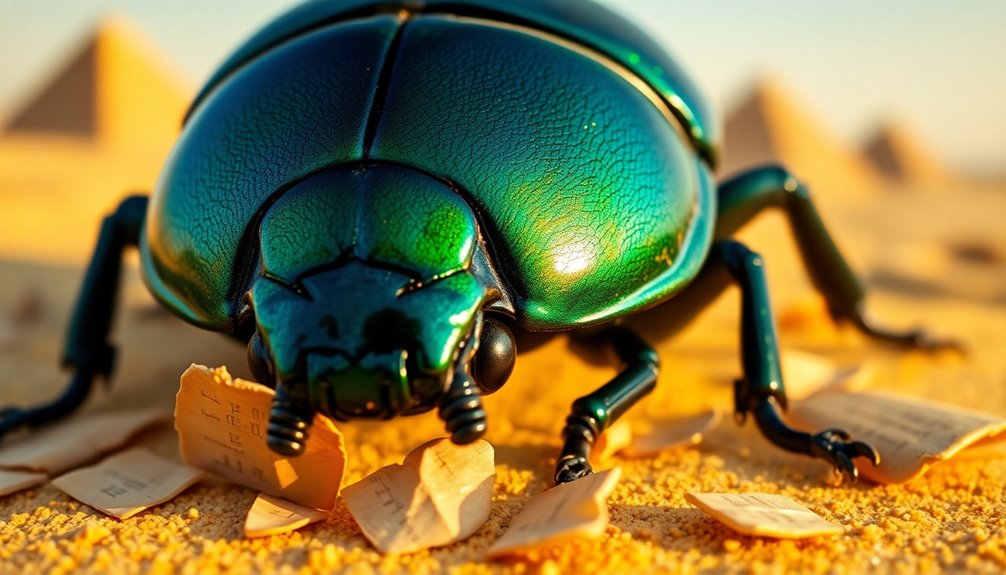
The ancient Egyptians held the scarab beetle, particularly Scarabaeus sacer, in high regard, viewing it as a powerful symbol of life and rebirth. In ancient Egyptian religion, the scarab represented regeneration, closely linked to the sun god Khepri, who embodied the rising sun and creation.
As you explore Egyptian art and artifacts, you'll notice that scarabs adorn jewelry and amulets, serving not just as decorative items but as potent symbols of protection and good luck for their wearers.
Heart scarabs, specifically designed for the deceased, highlight the significance of the heart in the afterlife. Placed on the chest during mummification, these scarabs guaranteed a safe passage into the next world.
The rolling of dung balls by scarab beetles also reflects the cycle of life and death, reinforcing the belief in rebirth—a central theme in ancient Egyptian thought.
Beyond their spiritual significance, scarabs functioned as administrative seals, symbolizing power and authority. Inscriptions chronicling important events in pharaohs' lives often appeared on these amulets, further cementing their status as crucial symbols in ancient Egyptian culture.
Scarabs in Funerary Practices
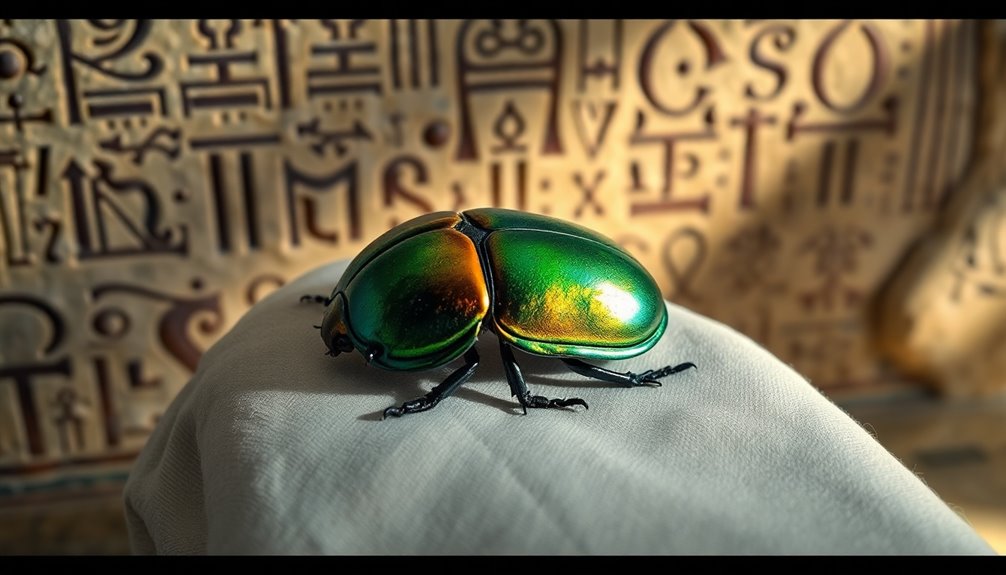
Scarabs played an essential role in ancient Egyptian funerary practices, reflecting their deep-seated beliefs in life after death. Heart Scarabs, in particular, were placed on the chest of the deceased during mummification to guarantee protection and support their journey to the afterlife. These amulets were believed to possess supernatural powers, helping the deceased's heart weigh favorably against the feather of Ma'at during judgment.
Scarabs were often inscribed with spells and texts to provide guidance and protection as the deceased navigated the afterlife. Their presence in tombs symbolized rebirth and resurrection, reinforcing the ancient Egyptians' faith in eternal life.
| Scarabs in Funerary Practices | Meaning |
|---|---|
| Heart Scarabs | Protection during judgment |
| Mummification | Preparation for the afterlife |
| Amulets | Supernatural guidance |
| Funerary Scarabs | Connection to eternal life |
| Symbols of Resurrection | Hope for rebirth |
The placement of scarab amulets in tombs reflected the belief in their protective qualities, guaranteeing a smooth passage to the afterlife for the deceased.
Cultural Impact and Modern Relevance
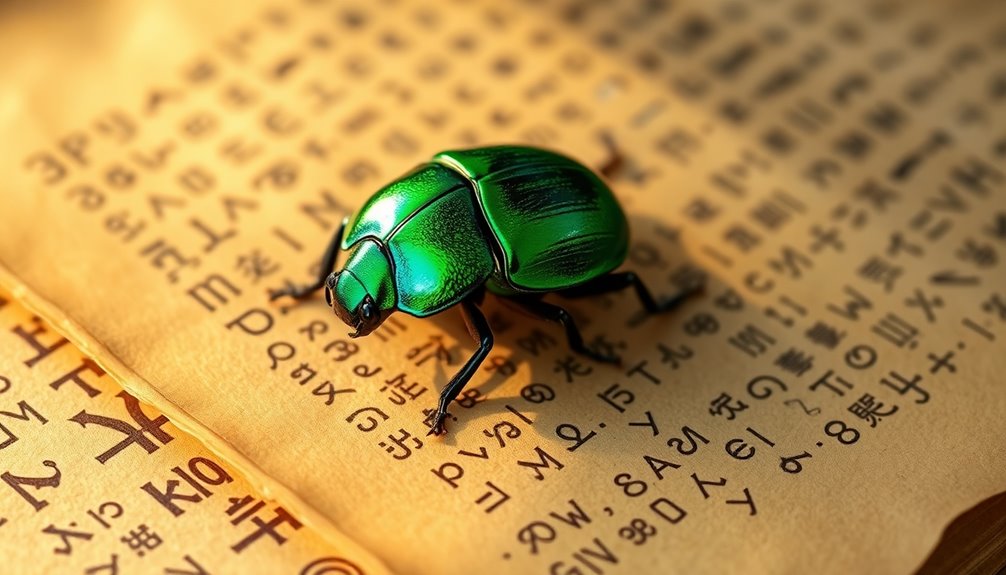
Throughout history, the scarab beetle's symbolism has captivated people's imaginations, evolving into a powerful emblem of protection and good fortune. This Egyptian cultural symbol transcends time, finding its way into modern jewelry and art. You can see scarab motifs in necklaces, bracelets, and tattoos, often representing themes of rebirth and regeneration, connecting you to the ancient Egyptians' beliefs.
As you explore Egypt, you'll likely encounter scarab replicas and amulets marketed as souvenirs, blending the reverence for history with contemporary consumer culture. The enduring appeal of the scarab beetle showcases its significance beyond ancient times, inspiring various forms of media and design that keep these legends alive.
Moreover, the ecological importance of scarabs continues to be a topic of interest, as they play a vital role in their ecosystems. Engaging with this rich history allows you to appreciate not just the symbolism but also the environmental relevance of these fascinating creatures.
In today's world, the scarab beetle remains a potent symbol, reminding you of the interconnectedness of protection, good luck, and the cycle of life.
Frequently Asked Questions
What Does the Egyptian Beetle Symbolize?
The Egyptian beetle, particularly the scarab, symbolizes life and regeneration.
When you think of this beetle, imagine its connection to the sun god Khepri, representing daily rebirth and creation.
It's more than just a creature; it embodies protection and good fortune, often used as amulets to guarantee safe passage to the afterlife.
In art and jewelry, the scarab reflects its significance in ancient Egyptian culture, reminding you of immortality and divine manifestation.
What Does the Scarab Beetle Symbolize Spiritually?
The scarab beetle symbolizes powerful spiritual themes like regeneration, rebirth, and transformation.
When you think of the scarab, you might picture its role in ancient Egyptian spirituality, representing the sun god Khepri and the eternal cycle of life and death.
It's believed that scarabs protect the heart in the afterlife, serving as amulets that guarantee safe passage.
This connection emphasizes the idea of renewal and the soul's journey toward enlightenment and ascension.
What Is the Meaning of the Egyptian Winged Scarab Beetle?
The Egyptian winged scarab beetle symbolizes rebirth and protection.
When you see this beetle, think of the sun's daily resurrection, signifying the eternal cycle of life.
In ancient culture, these scarabs were often included in funerary practices to aid souls in their passage to the afterlife.
You'd also find them as amulets for the living, offering good fortune and connecting people to divine powers, reflecting their deep spiritual significance.
What Is the Secret Beetle in Egypt?
The secret beetle in Egypt is the scarab beetle.
You'll find it symbolizes life, regeneration, and resurrection, closely tied to the sun god Khepri. Ancient Egyptians revered this beetle for its role in funerary practices, using heart scarabs to protect the deceased.
Its behavior of rolling dung inspired beliefs about the cyclical nature of life.
Today, scarabs still represent rebirth and good fortune, appearing in art and jewelry around the world.
Conclusion
In the grand tapestry of history, the Egyptian beetle whispers secrets of renewal and protection. As you unravel the mysteries of these remarkable creatures, you'll find they embody hope and transformation, guiding souls through the eternal journey. Their vibrant symbolism continues to inspire, reminding you that even in the face of change, life's cycles bring beauty. So, carry these timeless messages with you, and let the spirit of the scarab illuminate your own path forward.
